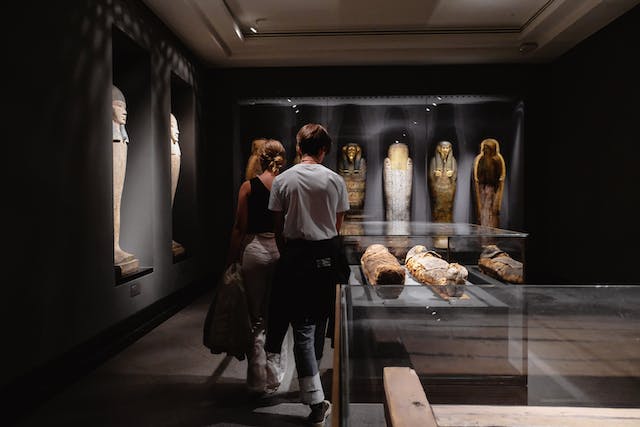
How was a mummy made? Along with many other steps, a mummy was made by emptying the body, preserving and drying it, and then carefully wrapping it.
The mummies from Egypt are probably the most famous, but they were not the only people to make them. The Incans, some aboriginal Australian tribes, the Aztecs, some other African tribes, and ancient Europeans have all practiced mummification at some time or other. Egyptian mummies are probably the most famous because the very dry climate in Egypt is perfect for preserving bodies. In order for a body to rot, bacteria are necessary and bacteria need water to function. If you can take the water out of a body, it won’t rot. This is why we can have jerky and leave it on a table with no problem.
Because of this phenomenon, many of the early mummies were made by accident. Several mummified bodies have been found in deserts around the world. The heat, lack of rain, and salt in the sand all act to remove the water from the body. Some of these mummies are very old. The oldest one found so far is 9,400 years old and there are probably more that we haven’t found yet. Bodies can also be mummified in ice. Water prevents bacteria from working, but so does low temperature. Bacteria cease functioning at temperatures lower than -9.5℃, so bodies that are frozen in the permafrost will be mummified. Wind can do the same thing. Some bodies that were left high up in the mountains are cooled by the temperature but also dried by the strong and cold winds, leaving them mummified. And bogs can mummify bodies as well. Bogs have the water that bacteria need, but they don’t have any oxygen and they are very acidic. There is also a moss called sphagnum that uses all of the nutrients that bacteria would need.
So, how is a mummy mummified? Different methods were used by the different cultures around the world and the quality varied greatly depending on how much money the family of the deceased had. It is for this reason that most of the mummies we have are those of wealthy people. Let’s look at how Tutankhamun was mummified.
Tutankhamun was born in approximately 1305 BC and he died in approximately 1286 BC. He was 19 years old when he died. Nobody knows how he died, but it probably wasn’t murder. He was a pharaoh so only the most important priests worked on his mummy and the process took them 70 days.
The first step in making a mummy is to remove the brain and the organs. When we die, the bacteria that eat our bodies are the ones that live in our stomach and intestines. Our immune system keeps them where they are and the lining of our stomach and intestines regrows every few days because the bacteria eat it. Once we are dead, the lining stops regrowing and the bacteria are free to feast. To prevent this, the brain and the organs had to be removed from the body and this had to be done fairly quickly after death because decomposition starts very rapidly. The organs were removed via a cut in the left side of the abdomen but the brain was removed through the nose. This was done with a special hooked instrument that was pushed up the nasal cavity and the brain was pulled out in pieces. The heart was left in the chest because they believed the heart was the center of being. Once all the organs had been removed, they were preserved and placed in pottery jars called canopic jars.
The next step was drying the body. The body was laid out and covered in natron. Natron occurs naturally and it is a mix of sodium carbonate and sodium bicarbonate. It is often found in lake beds that have dried up, such as those in Ancient Egypt. Natron is a salt, and it absorbs water extremely well. The body was covered in natron and natron would be spread inside the body as well. It would be left for 70 days to remove all of the water. Natron also raises the pH of the body, making it inhospitable to bacteria.
After about 40 days, the drying out body might start to deform, so packs of linen were inserted into the body to give it shape. After 70 days, the natron was wiped off and the body was prepared for wrapping. Wrapping was a lengthy process and about 150 m of linen was used to wrap it. The first layer of linen was wrapped tightly, and the priest would even wrap between individual fingers and toes. Amulets and charms were placed between layers and then wrapped over. After a few layers had been wrapped, the body was painted with warm resin, and then the wrapping continued. Before the final layer, a mask of the face was placed over the head and then the final layer was wrapped on. The last layer was secured with resin and the mummy was complete. It then had to be prepared for burial.
Tutankhamun’s mummy was unwrapped by Howard Carter and a team of experts in 1925. They found 140 precious amulets and other objects and 17 layers of linen bandages. They were all placed in specific places that were laid out in the Egyptian Book of the Dead. And this is what I learned today.
Photo by Shvets Anna: https://www.pexels.com/photo/man-and-woman-across-mummies-2570068/
Sources
https://www.si.edu/spotlight/ancient-egypt/mummies
https://handwovenmagazine.com/linen-egypt-and-mummies/
https://www.history.com/topics/folklore/history-of-the-mummy
https://en.wikipedia.org/wiki/Natron
https://en.wikipedia.org/wiki/Canopic_jar
https://www.mcgill.ca/oss/article/general-science/death-our-body-feasts-itself
https://www.nationalgeographic.com/science/article/natural-mummies-accident
